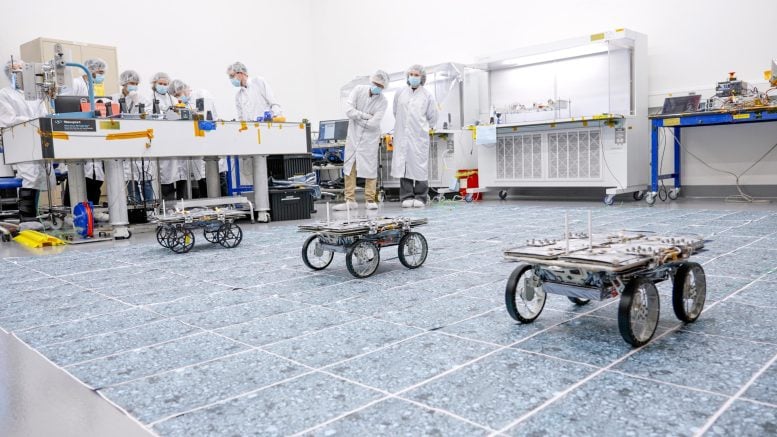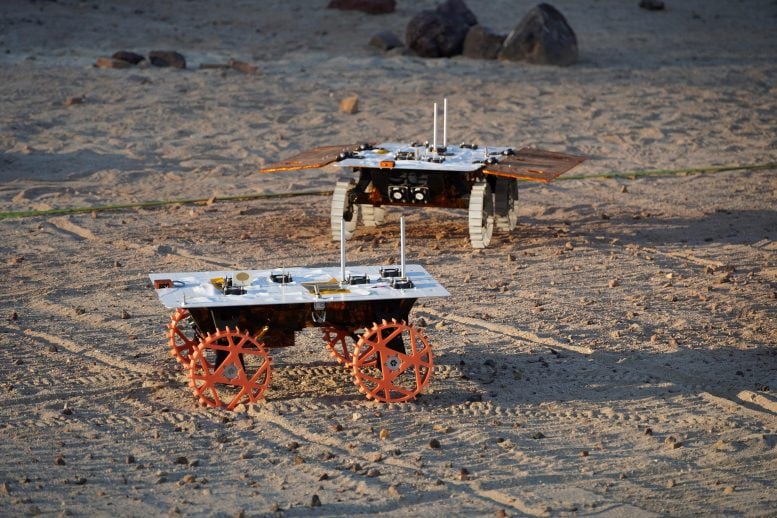
Part of NASA’s CADRE technology demonstration, three small rovers that will explore the Moon together show off their ability to drive as a team autonomously – without explicit commands from engineers – during a test in a clean room at the agency’s Jet Propulsion Laboratory in December 2023. Credit: NASA/JPL-Caltech
Construction and testing are complete on the CADRE rovers, which will map the lunar surface together as a tech demo to show the promise of multirobot missions.
A trio of small rovers that will explore the Moon in sync with one another are rolling toward launch. Engineers at <span class="glossaryLink" aria-describedby="tt" data-cmtooltip="
” data-gt-translate-attributes=”[{"attribute":"data-cmtooltip", "format":"html"}]” tabindex=”0″ role=”link”>NASA’s Jet Propulsion Laboratory in Southern California recently finished assembling the robots, then subjected them to a punishing series of tests to ensure they’ll survive their jarring rocket ride into space and their travels in the unforgiving lunar environment.
Part of a technology demonstration called CADRE (Cooperative Autonomous Distributed Robotic Exploration), each solar-powered rover is about the size of a carry-on suitcase. The rovers and associated hardware will be installed on a lander headed for the Moon’s Reiner Gamma region. They’ll spend the daylight hours of a lunar day – the equivalent of about 14 days on Earth – conducting experiments by autonomously exploring, mapping, and using ground-penetrating radar that will peer below the Moon’s surface.

Members of the CADRE assembly, test, launch, and operations team pose with completed hardware in a clean room at JPL in late January. Behind the three rovers are the situational awareness camera assembly, one of the deployers that will lower the rovers onto the lunar surface, and the base station. Credit: NASA/JPL-Caltech
The goal is to show that a group of robotic spacecraft can work together to accomplish tasks and record data as a team without explicit commands from mission controllers on Earth. If the project succeeds, future missions could include teams of robots spreading out to take simultaneous, distributed scientific measurements, potentially in support of astronauts.
Engineers have put in long hours test-driving rovers and working out bugs to finish the hardware, get it through testing, and prepare it for integration with the lander.
[embedded content]
Clamped to a shaker table, one of NASA’s CADRE rovers gets shaken vigorously during a test in November 2023. This vibration test is designed to show that the rover can withstand the jarring rocket ride on its journey to the Moon aboard a lunar lander. Credit: NASA/<span class="glossaryLink" aria-describedby="tt" data-cmtooltip="
” data-gt-translate-attributes=”[{"attribute":"data-cmtooltip", "format":"html"}]” tabindex=”0″ role=”link”>JPL-Caltech
“We have been in overdrive getting this tech demo ready for its lunar adventure,” said Subha Comandur, CADRE project manager at JPL. “It’s been months of nearly round-the-clock testing and sometimes re-testing, but the team’s hard work is paying off. Now we know these rovers are ready to show what a team of little space robots can accomplish together.”
Shake and Bake
While the list of tests is extensive, the most brutal involve extreme environmental conditions to ensure the rovers can withstand the rigors of the road ahead. That includes being locked in a thermal vacuum chamber that simulates the airless conditions of space and its extreme hot and cold temperatures. The hardware also gets clamped to a special “shaker table” that vibrates intensely to make sure it will endure the journey out of Earth’s atmosphere.

A CADRE rover is prepared for electromagnetic interference and compatibility testing in a special chamber at JPL in November 2023. Such testing confirms that the operation of the electronic subsystems do not interfere with each other nor with those on the lander. Credit: NASA/JPL-Caltech
“This is what we submit our rovers to: ‘shake’ to simulate the rocket launch itself and ‘bake’ to simulate the extreme temperatures of space. It’s very nerve-wracking to witness in person,” said JPL’s Guy Zohar, the project’s flight system manager. “We’re using many carefully selected commercial parts on our project. We expect them to work, but we’re always a little worried when we go into testing. Happily, each test has ultimately been successful.”
Engineers also performed environmental testing on three hardware elements mounted on the lander: a base station that the rovers will communicate with via mesh network radios, a camera that will provide a view of the rovers’ activities, and the deployer systems (see video below) that will lower the rovers to the lunar surface via a fiber tether fed slowly out from a motorized spool.
[embedded content]
Engineers tested the system that will lower three small rovers onto the lunar surface when NASA’s CADRE (Cooperative Autonomous Distributed Robotic Exploration) technology demonstration arrives at the Moon aboard a lunar lander. The test took place in a clean room at NASA’s Jet Propulsion Laboratory in Southern California in December 2023. Three deployer systems will be installed on the lander – one for each rover. Credit: NASA/JPL-Caltech
Putting Code to the Test, Too
Meanwhile, engineers working on CADRE’s cooperative autonomy software have spent many days in JPL’s rocky, sandy Mars Yard with full-scale versions of the rovers called development models. With flight software and autonomy capabilities aboard, these test rovers showed they can accomplish key goals for the project. They drove together in formation. Faced with unexpected obstacles, they adjusted their plans as a group by sharing updated maps and replanning coordinated paths. And when one rover’s battery charge was low, the whole team paused so they could later continue together.

Two full-scale development model rovers are tested in JPL’s Mars Yard in August 2023 as part of NASA’s CADRE tech demo. These tests confirmed the project’s hardware and software can work together to accomplish key goals. Credit: NASA/JPL-Caltech
The project conducted several drives at night under large flood lamps so the rovers could experience extreme shadows and lighting that approximate what they’ll encounter during the lunar daytime.
After that, the team performed similar drive tests with flight models (the rovers that will go to the Moon) in a JPL clean room. When the spotless floor there proved a bit slippery – a texture different from the lunar surface – the robots got out of formation. But they stopped, adjusted, and proceeded on their planned path.
“Dealing with curveballs – that’s important for the autonomy. The key is the robots respond to things going off plan, then they replan and are still successful,” said JPL’s Jean-Pierre de la Croix, CADRE principal investigator and autonomy lead. “We’re going to a unique environment on the Moon, and there will, of course, be some unknowns. We’ve done our best to prepare for those by testing software and hardware together in various situations.”
Next, the hardware will ship to Intuitive Machines for installation on a Nova-C lander that will launch atop a <span class="glossaryLink" aria-describedby="tt" data-cmtooltip="
” data-gt-translate-attributes=”[{"attribute":"data-cmtooltip", "format":"html"}]” tabindex=”0″ role=”link”>SpaceX Falcon 9 rocket from NASA’s Kennedy Space Center in Florida.
